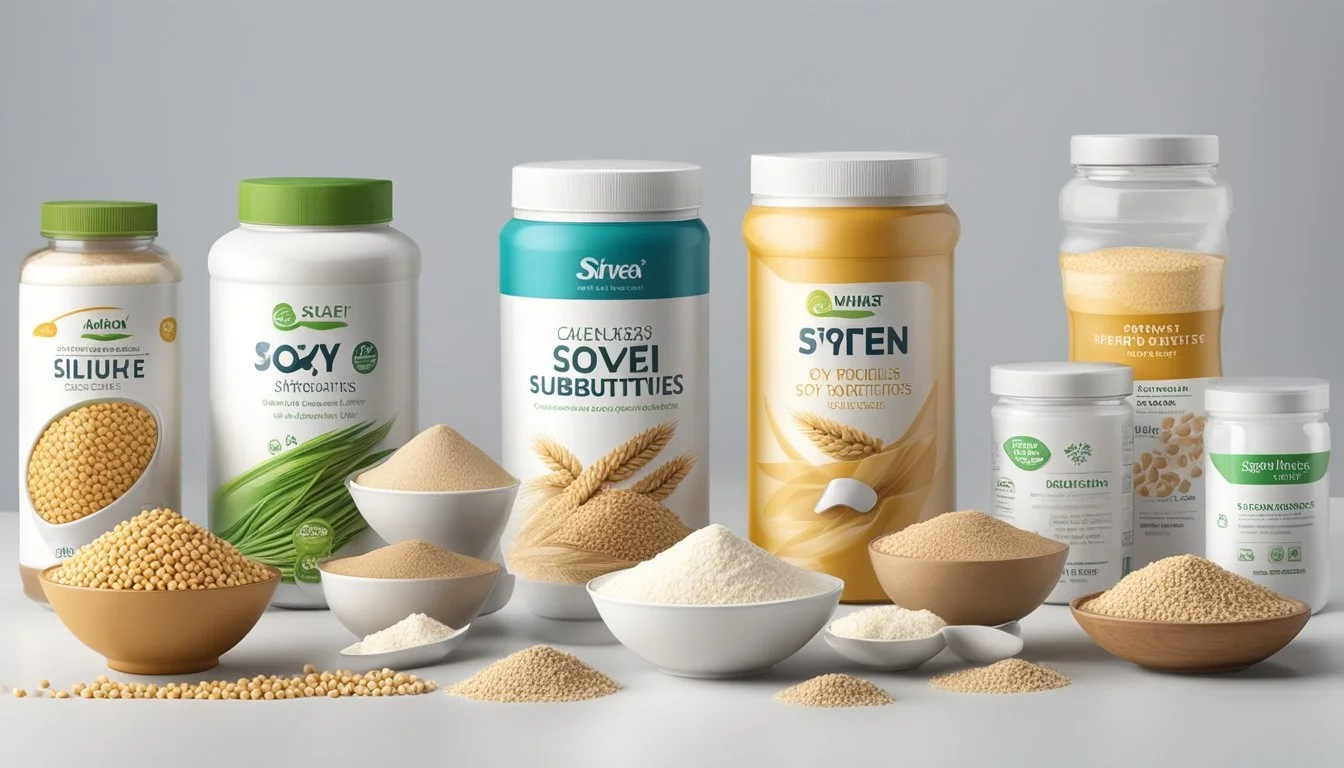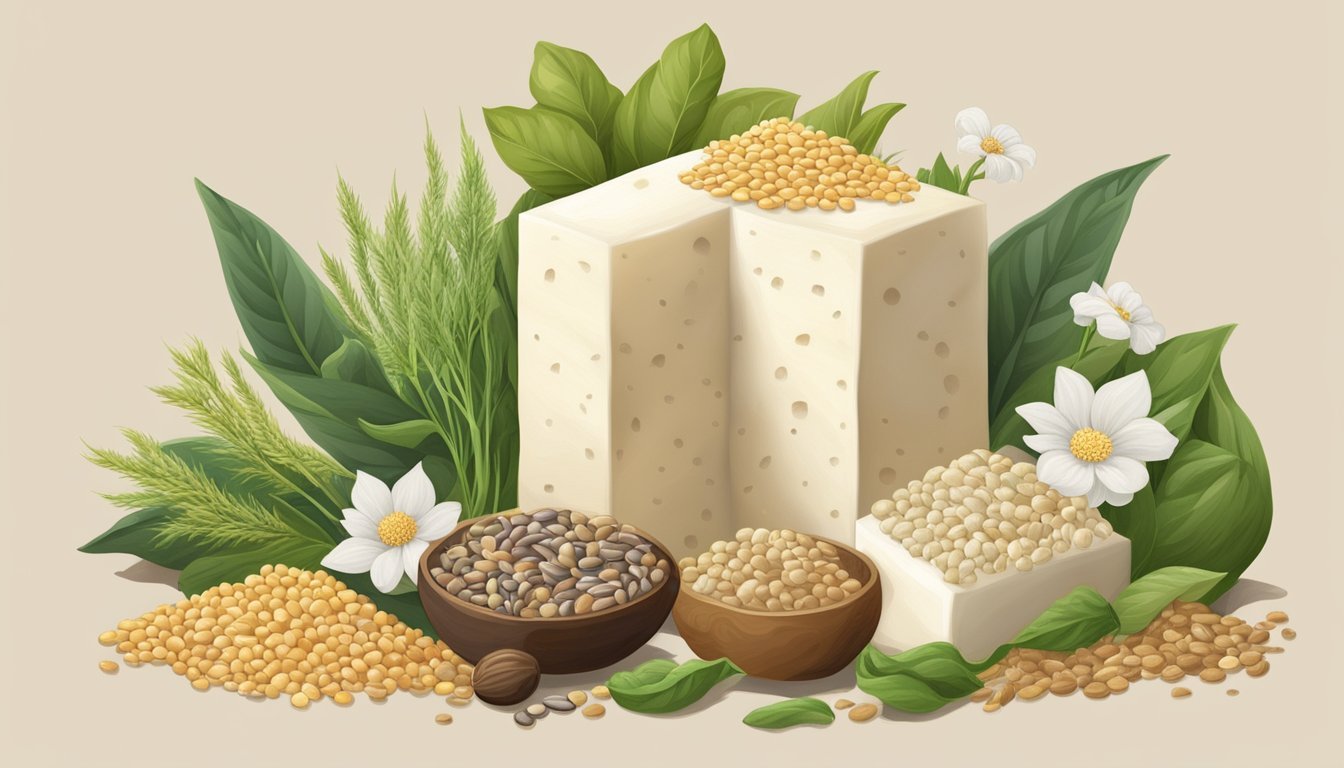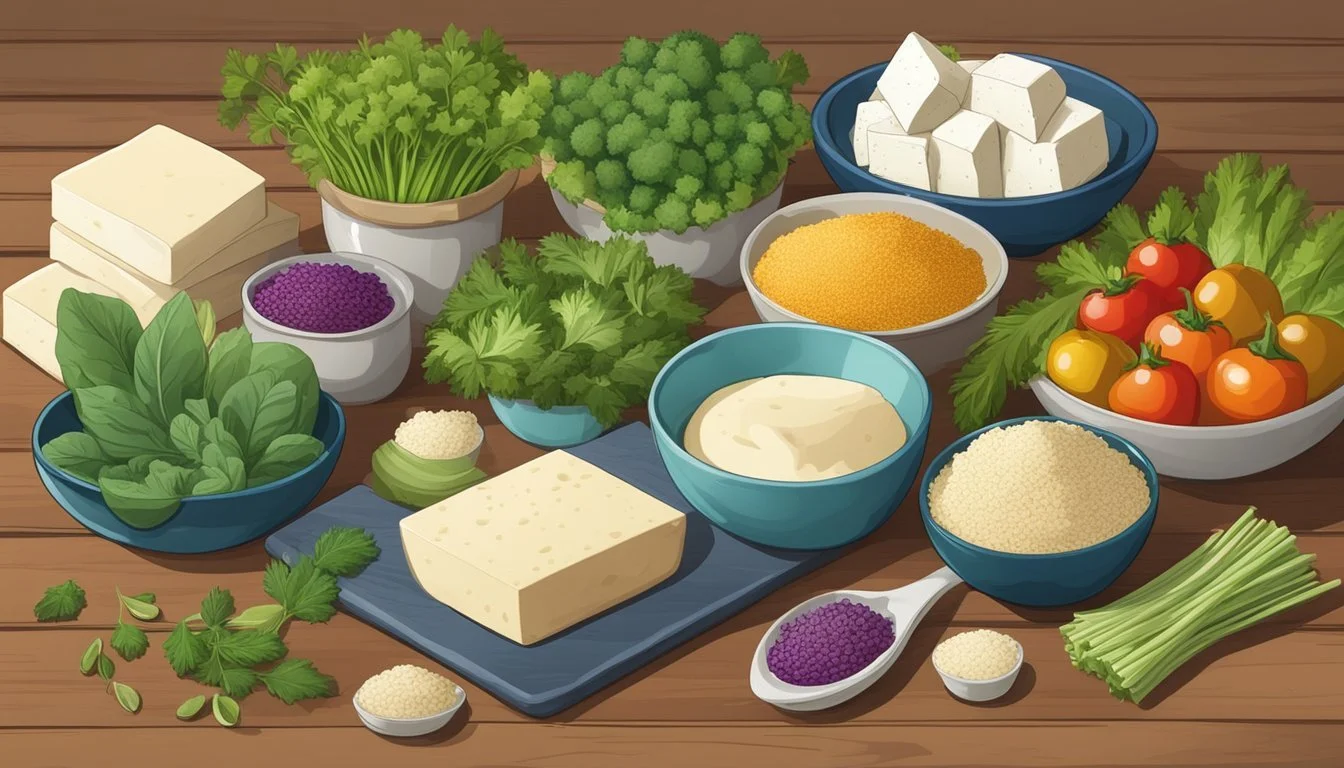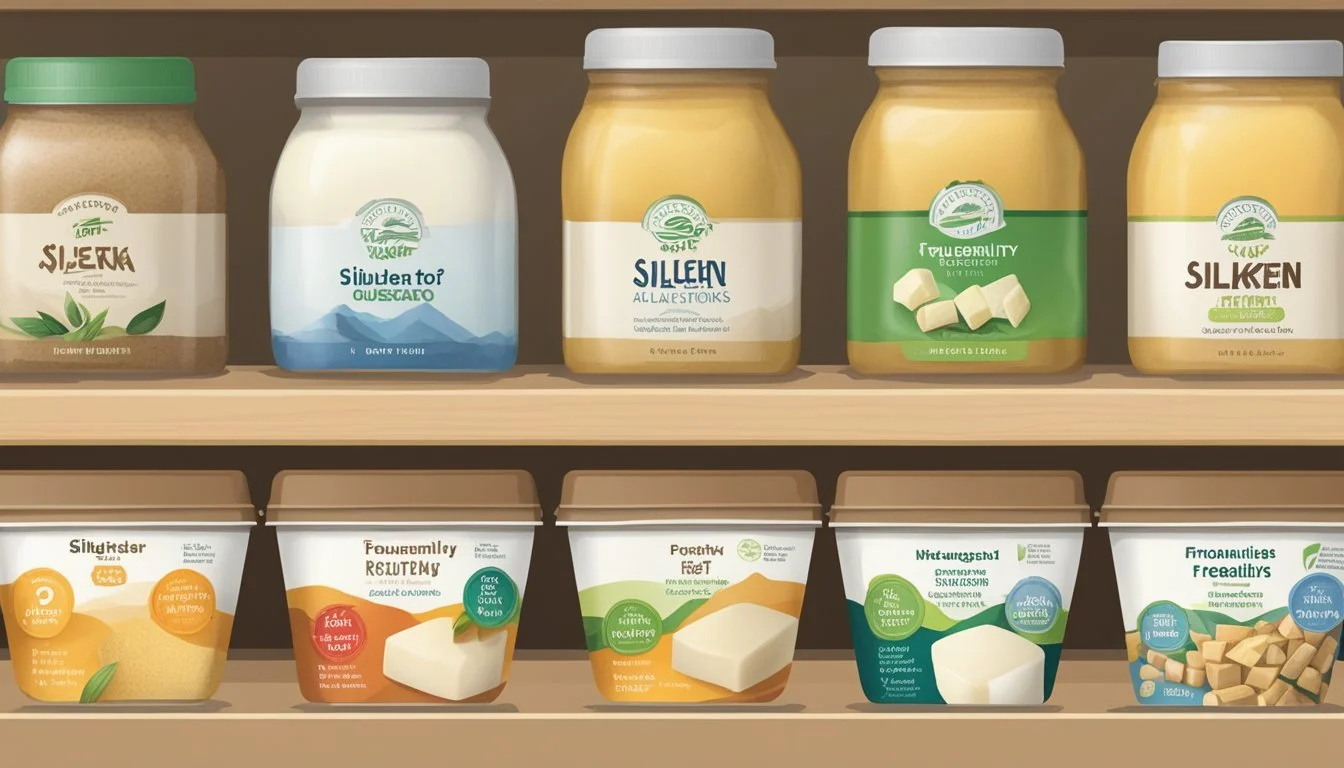Silken Tofu Substitutes
Top Alternatives for Your Recipes
Silken tofu, known for its smooth and creamy texture, is a staple ingredient in many vegetarian and vegan dishes. Its unique consistency makes it ideal for use in desserts, smoothies, sauces, and dressings. Due to dietary preferences, allergies, or simply personal taste, individuals often seek alternatives to silken tofu that can deliver a similar texture and versatility in dishes. There are various substitutes that can mimic the qualities of silken tofu while providing their own unique flavors and nutritional profiles.
Chickpea flour mixed with a plant-based milk can offer a soy-free alternative, especially for scrambles and egg-like preparations. Tempeh, although firmer, can be used in recipes where a denser texture is desirable. It's also soy-based and provides a nutty flavor that can enhance a variety of dishes. For those looking for a substitute that can add creaminess as well as richness, pureed cashews or blended white beans are excellent choices. These alternatives not only cater to those avoiding soy but also add an extra dimension of flavor and nutritional benefits to the culinary creations they're used in.
Understanding Silken Tofu
Silken tofu, derived from soybeans, is a distinct variety of tofu celebrated for its creamy texture and versatility in culinary applications, ranging from smoothies to desserts.
What Makes Silken Tofu Unique
Silken tofu is made from soybeans, water, and a coagulant, but sets it apart is its high water content. Unlike firmer tofu varieties, silken tofu undergoes a unique manufacturing process in which it is not pressed, resulting in a higher retention of water. This process gives silken tofu a custard-like texture, making it incredibly smooth and soft. It is available in different consistencies from soft to firm, but even the firmest silken tofu will have a delicate structure that sets it apart from other tofus.
Roles of Silken Tofu in Recipes
In recipes, silken tofu serves multiple roles due to its mild flavor and smooth texture. It's a plant-based protein source that blends seamlessly into recipes, adding nutritional value without overpowering other ingredients. Two of its most common uses include:
Smoothies: Silken tofu provides a protein boost and contributes a creamy consistency without altering taste.
Desserts: It acts as a dairy substitute, often used in vegan versions of puddings, mousses, and cheesecakes.
Additionally, silken tofu's moisture-rich nature makes it ideal for pureeing into sauces, dressings, and even some soup bases, where it imparts a rich, silky quality without the need for dairy or heavy creams.
Health and Nutrition of Silken Tofu Substitutes
When exploring silken tofu substitutes for dietary considerations, one focuses on protein content and the profile of fats and calories. These factors contribute significantly to the overall healthfulness of the alternatives.
Protein Sources in Substitutes
Substitutes for silken tofu come in various forms, each with a different protein content. For instance, chickpea flour and seitan are notable for their high protein levels. Chickpea flour, used to make Burmese tofu, provides a soy-free option, rich in both protein and fiber. Seitan, made from wheat gluten, offers a protein structure similar to that of meat, although it may not be suitable for those with gluten sensitivities.
Chickpea Flour: A good source of protein and fiber, chickpea flour can serve as a nutritious substitute for silken tofu.
Seitan: High in protein, it is a viable alternative for those who do not require a gluten-free diet.
Comparing Fat and Calorie Content
In terms of fat and calorie content, alternatives to silken tofu can vary. Here's a comparison of silken tofu and two common substitutes:
Substitute Fat Content Calorie Content Silken Tofu Low in fat, with minimal saturated fat Relatively low in calories Chickpea Flour Higher in fat, but contains healthy unsaturated fats Moderate in calories, considering the fiber content which aids in satiety Seitan Low in saturated fat Varying calories depending on preparation, generally low to moderate
Silken tofu itself is low in fat, particularly saturated fat, and is also lower in calories, making it a healthful option. Its substitutes, such as chickpea flour, may introduce more fat but predominantly in the form of unsaturated fats, which are beneficial for heart health. Seitan is low in fat and is relatively low in calories unless additional fats are used in its preparation.
Plant-Based Silken Tofu Alternatives
Navigating the diverse realm of silken tofu substitutes, one can find ample plant-based options catering to vegans and vegetarians. These alternatives deliver similar textures and are rich in plant-based proteins, ideal for dairy-free and soy-free diets.
Soy-Based Substitutes
Soy Milk-Based Tofu Alternative:
Preparation: Derived from soy milk, this alternative maintains a comparable protein content to traditional tofu.
Texture: It achieves a similar smoothness to silken tofu, making it suitable for creamy dishes.
Tempeh:
Characteristics: With a firmer texture, tempeh is a fermented soy product that can be softened for use in recipes requiring silken tofu.
Non-Soy Plant Proteins
Chickpea Flour Tofu:
Preparation: Mixed with water and a plant-based liquid such as almond milk, chickpea flour sets into a tofu-like consistency.
Usage: Can be utilized in tofu scrambles and savory mixtures.
Burmese Tofu:
Base: Made from chickpea flour, this alternative is entirely soy-free.
Texture: Offers a gelatinous quality that can recreate the feel of silken tofu in various dishes.
Legume-Based Tofu (Red Lentil Tofu):
Process: Red lentils are ground, cooked, and coagulated to form a protein-rich, soy-free tofu.
Benefits: Adds a unique flavor whilst being a nutritious option for those avoiding soy.
Legumes as Silken Tofu Replacements
Replacing silken tofu in recipes often involves finding alternatives that offer similar texture and nutritional benefits. Legumes, with their rich protein structure and versatility, are excellent choices for those seeking comparable consistency and health attributes.
Chickpeas and Chickpea Flour
Chickpeas: These legumes are a fiber-rich protein source that can mimic the soft texture of silken tofu, making them a perfect ingredient for creamy soups and sauces. When used as a meat substitute, chickpeas provide a satisfactory chewiness and absorb flavors well.
Chickpea Flour: A soy-free alternative for silken tofu is chickpea flour, which can be mixed with a plant-based liquid like almond milk to achieve a similar consistency for dishes such as tofu scramble. The mixture is versatile and can be seasoned and cooked to suit various recipes that typically demand silken tofu.
Preparation:
Combine chickpea flour with a plant-based liquid in a 1:1 ratio.
Season with spices such as turmeric for color and flavor.
Lentils and Beans
Lentils: Particularly red lentils offer a beautiful blush-colored tofu alternative when processed. Their high protein content aligns them closely with the nutritional profile of silken tofu and their soft texture when cooked makes them suitable for creating faux silken tofu.
Instructions:
Puree cooked lentils to a smooth consistency.
Use as a base in dips or desserts where silken tofu is called for.
Beans: A broad range of beans, including kidney beans and pinto beans, offer the richness and protein needed in dishes where silken tofu is traditionally used. Their high fiber content contributes to a satisfying texture and they can carry a dish's main flavors excellently.
Examples:
Kidney Beans: Work well in hearty soups and blended spreads.
Pinto Beans: A suitable addition to creamy pastas or as a thickener in gravies.
Utilizing legumes as silken tofu substitutes not only addresses dietary restrictions but also enhances meals with their inherent flavors and nutritional values. The legumes discussed offer both protein and fiber, essential for a balanced diet, while ensuring a similar consistency and versatility in cooking as that offered by silken tofu.
Soy and Wheat Protein-Based Substitutes
In the realm of plant-based proteins, soy and wheat provide robust alternatives to silken tofu. They are particularly favored for their high protein content and versatility in texture and flavor.
Tempeh's Role as a Substitute
Tempeh, made through soybean fermentation, stands out with its firm texture and nutty flavor. The fermentation process not only enhances its nutritional profile but also gives tempeh a unique taste that can complement a variety of dishes. It offers a substantial protein boost, making it a suitable stand-in for silken tofu especially in recipes where a heartier texture is desired.
Nutritional Benefit: Rich in protein, prebiotics due to fermentation
Best Used In: Salads, stir-fries, sandwiches
Seitan and Its Uses
Seitan is another worthy mention; it is created from wheat gluten and is widely appreciated in the vegetarian and vegan community for its meat-like consistency. Seitan excels as a silken tofu substitute mainly in savory dishes where its chewy texture can mimic meat.
Primary Ingredient: Vital wheat gluten
Texture: Dense and chewy, similar to meat
Common Uses: Simulates chicken or beef in recipes
Both tempeh and seitan have carved a niche in the plant-based diet as they cater to those looking for alternatives to tofu that do not sacrifice protein quantity or a satisfying eating experience.
Grains and Seeds Alternatives
In the realm of plant-based cooking, grains and seeds stand as versatile substitutes for silken tofu, particularly when high-protein content and a neutral palette are desired.
Quinoa and Other High-Protein Grains
Quinoa, (What wine goes well with quinoa?) a pseudo-cereal, is revered for its complete protein profile, including all nine essential amino acids, making it an excellent replacement for tofu in terms of nutritional value.
Quinoa: One can simmer it until it's fluffy and soft, resembling the texture of silken tofu when used in dishes.
Amaranth: With a protein composition similar to quinoa, amaranth is another grain that can thicken dishes while adding nutritive benefits.
Teff: Though small in size, teff offers a high protein count and a mild, nutty flavor, well-suited for grain-based dishes as a tofu stand-in.
Nuts and Seeds Varieties
Nuts and seeds can replicate the creamy texture of silken tofu and provide a boost of protein, making them a common choice in various recipes.
Chia seeds: Ideal for puddings and smoothies, these seeds absorb liquid and create a gel-like consistency akin to silken tofu.
Hemp seeds: Known for their high protein content, hemp seeds can be blended into smoothies or combined with water to create hemp seed tofu.
Almonds: Ground almonds or almond butter can be used to give body and creaminess to sauces and desserts, similar to silken tofu.
By incorporating these grains and seeds alternatives, chefs and home cooks alike can achieve the desired consistency and protein levels of traditional silken tofu preparations.
Dairy and Egg Substitutes
When considering vegan or dairy-free alternatives, silken tofu stands out as a substitute for certain dairy products and eggs. Its versatility allows for its inclusion in a variety of recipes where texture and binding properties are paramount.
Cheese and Yogurt
Cheese: For dishes that require the creaminess of cheese, such as dips and sauces, blended silken tofu can be an excellent alternative. It can mimic the soft texture of ricotta or cream cheese and is easily seasoned to enhance flavor.
Vegan cheesecakes may utilize silken tofu for its smooth, spreadable quality.
Yogurt: Silken tofu is also a viable substitute for yogurt. With the addition of lemon juice and a sweetener, one can achieve a yogurt-like tang and consistency:
Vegan yogurt bowls can be created by blending silken tofu until smooth and then mixed with fruits and sweeteners.
Egg Replacers
Silken tofu can effectively replace eggs in many recipes due to its binding properties. Here's a quick guide:
For Baking: Use a quarter cup of blended silken tofu as a substitute for one egg. This works particularly well in dense baked goods.
For Scrambles: Crumbled firm tofu, seasoned with turmeric and nutritional yeast, can replicate the look and taste of scrambled eggs.
Using silken tofu as an egg replacer not only maintains the structure of the dish but also adds protein, making it a nutritious alternative for vegan and allergy-friendly cooking.
Unique Silken Tofu Substitutes
Exploring unique substitutes for silken tofu offers a spectrum of flavors and textures. These alternatives cater to various dietary needs and culinary applications.
Fruits and Vegetables
Avocado and banana lend their creamy textures to mimic silken tofu in certain dishes. Avocado, with its rich, buttery consistency, works exceptionally well in smoothies and as a base for creamy sauces. Banana, on the other hand, can act as a binder and moisture-provider in baking, similar to silken tofu.
Cauliflower: When steamed and pureed, cauliflower transforms into a silky substitute for tofu, suitable for savory recipes like soups and sauces.
Pumpkin: This vegetable offers a smooth, dense puree that is excellent in autumnal desserts and hearty entrées.
Fruit/Vegetable Best Used In Avocado Smoothies, sauces Banana Baking, desserts Cauliflower Soups, sauces Pumpkin Desserts, entrées
Molecular Gastronomy Ingredients
Molecular gastronomy provides innovative substitutes for silken tofu by utilizing gelatin and various starches.
Gelatin: A gelling agent that can replicate the textural properties of siliken tofu in desserts. It should be noted that gelatin is derived from animal products, and thus not suitable for vegetarians or vegans.
Cornstarch: This ingredient can thicken liquids to a tofu-like consistency. It is particularly effective when combined with non-dairy milks for a smooth texture.
Ingredient Properties Usage Note Gelatin Gelling agent, texture replicator Not vegetarian/vegan-friendly Cornstarch Thickener, creates smooth textures Combine with liquids for desired consistency
By incorporating these unique substitutes, chefs and home cooks can achieve the desired textures and flavors in their dishes without relying on silken tofu.
Cooking Techniques for Tofu Alternatives
When seeking tofu substitutes in recipes, it's crucial to address cooking techniques that cater to the alternative's unique properties. Texture and flavor are the key aspects in which substitutes differ from tofu and are transformed during cooking.
Adjusting for Texture and Moisture
Different tofu alternatives possess varying degrees of firmness and moisture content, which can affect the outcome of dishes such as stir-fries. For example, chickpea flour, used to mimic the soft texture of silken tofu, should be well-hydrated with a plant-based liquid to achieve the desired consistency. When sautéing, liquids from vegetables release additional moisture—an aspect to keep in mind to prevent sogginess.
To replicate tofu's texture, tempeh can be crumbled or sliced for stir-fries but lacks the inherent softness, so it should not be overcooked to maintain a pleasant bite. Tempeh's firmer nature means there's no need for pressing, a typical step when preparing tofu.
Seitan: Combining water and wheat gluten results in a meaty texture, suitable for denser recipes. It absorbs flavors well and should be cooked until just heated through to keep its texture intact.
Flavor Enhancement and Spices
Tofu alternatives may require extra seasoning to achieve a similar taste profile. Turmeric can impart a subtle earthy flavor and a vibrant color, akin to scrambled tofu. The use of lemon juice and other condiments can enhance the overall savoriness of a dish.
To elevate the flavor of tofu substitutes in stir-fries or scrambles:
Begin with a bold base: Sauté onions, garlic, and any desired vegetables to establish a flavor foundation.
Add spices: Including cumin, chili powder, or curry spices can bring depth and complexity.
Finish with acidity: A splash of lemon juice or vinegar can brighten flavors and balance richness.
By keeping in mind these texture and flavor adjustments, cooks can successfully incorporate a range of tofu substitutes into their meals, ensuring a delicious and satisfying experience.
Frequently Asked Questions
When considering a substitute for silken tofu, it is important to align your choice with the texture and flavor profile of the dish. This section addresses common concerns regarding tofu substitution, providing practical guidance for seamless culinary adjustments.
Choosing the Right Substitute
One often asks, "What makes a good substitute for silken tofu in recipes?" The choice largely depends on the intended use. For smooth and creamy applications like sauces or desserts, pureed avocado can offer a similar texture. For a soy-free tofu scramble, chickpea flour mixed with plant-based liquids emulates the original dish well. When texture is more critical than flavor, such as in an Asian stir-fry, seitan—a wheat gluten product—can mimic the bite of tofu. If not avoiding soy, tempeh is an excellent, firmer choice, while those not restricted by dairy might opt for paneer or halloumi.
Substitution Ratios and Tips
It's not enough to merely select a substitute; one must also understand the correct ratios for substitution to maintain the dish's integrity. For example, when replacing silken tofu:
Chickpea flour: Use 3 tablespoons of chickpea flour mixed with 3 tablespoons of water to replace approximately 100 grams of silken tofu.
Pureed avocado: Use a 1:1 ratio when substituting for silken tofu in sauces and desserts.
Tempeh: Generally, use about 1 cup of crumbled tempeh for every 1 cup of crumbled tofu.
Seitan: Replace equal amounts by weight, mindful that seitan’s wheat base contributes a denser texture.
When using these substitutes, remember to season your dishes well, as alternatives may carry different flavor profiles from silken tofu. Always taste and adjust as needed to achieve the best result.










